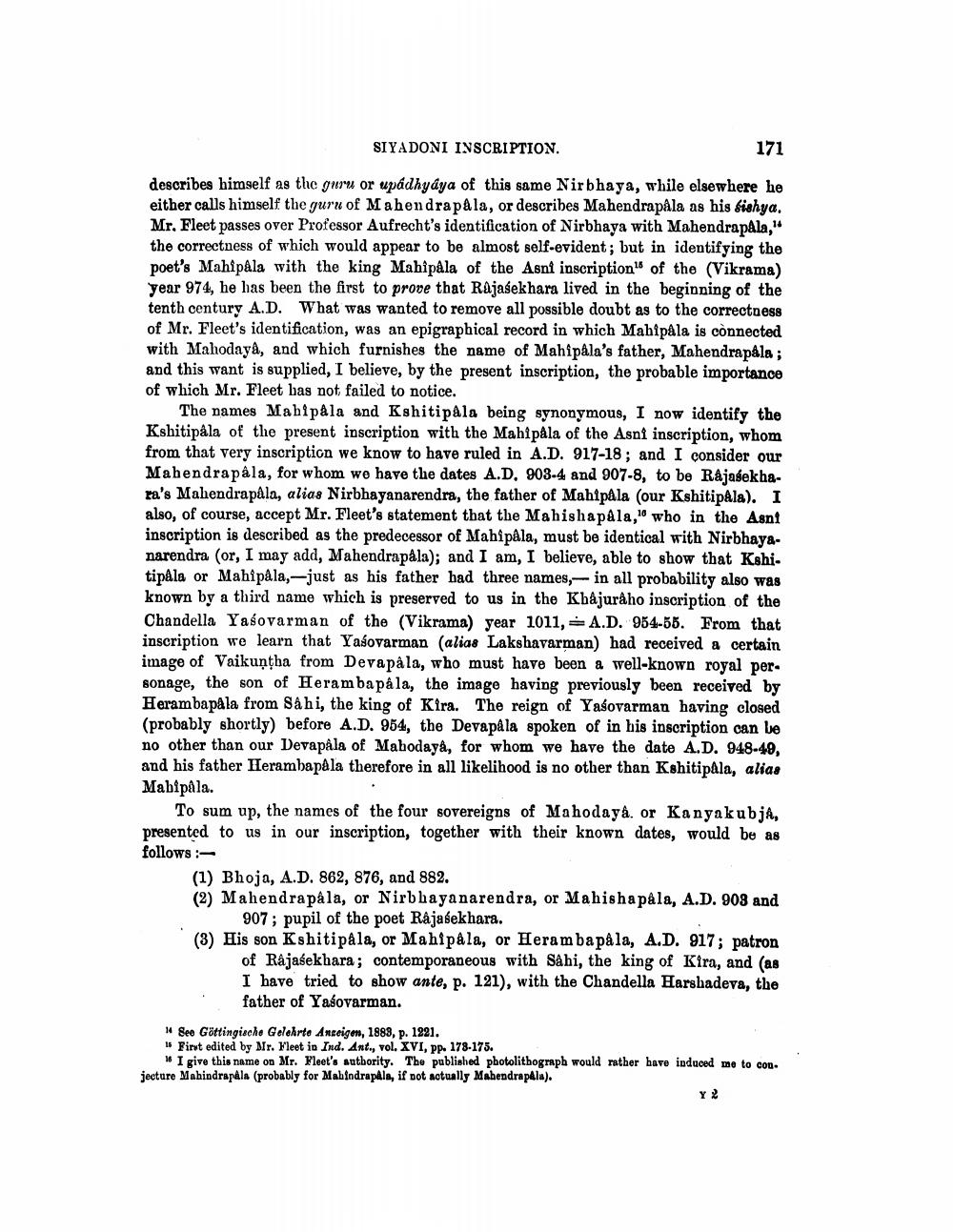________________
SIYADONI INSCRIPTION.
171
describes himself as the guru or upadhyaya of this same Nirbhaya, while elsewhere he either calls himself the guru of Mahendra påla, or describes Mahendrapâla as his fishya. Mr. Fleet passes over Professor Aufrecht's identification of Nirbhaya with Mahendrapala," the correctness of which would appear to be almost self-evident; but in identifying the poet's Mahipala with the king Mahlpåla of the Asat inscription" of the (Vikrama) year 974, he has been the first to prove that Rajasekhara lived in the beginning of the tenth century A.D. What was wanted to remove all possible doubt as to the correctness of Mr. Fleet's identification, was an epigraphical record in which Mahipala is connected with Mahodaya, and which furnishes the name of Mahipala's father, Mahendrapala; and this want is supplied, I believe, by the present inscription, the probable importance of which Mr. Fleet has not failed to notice.
The names Mahipala and Kshitipala being synonymous, I now identify the Kshitipala of the present inscription with the Mahipala of the Asnt inscription, whom from that very inscription we know to have ruled in A.D. 917-18; and I consider our Mahendrapâla, for whom we have the dates A.D. 903-4 and 907-8, to be Rajasekhara's Mahendrapala, alias Nirbhayanarendrs, the father of Mahipala (our Kshitipala). I also, of course, accept Mr. Fleet's statement that the Mahishapala," who in the Asni inscription is described as the predecessor of Mahipala, must be identical with Nirbhayanarendra (or, I may add, Mahendrapâla); and I am, I believe, able to show that Kshitipâla or Mahipala,-just as his father had three names, in all probability also was known by a third name which is preserved to us in the Khâjurâho inscription of the Chandella Yasovarman of the (Vikrama) year 1011, A.D. 954-55. From that inscription we learn that Yasovarman (alias Lakshavarman) had received a certain image of Vaikuntha from Devapâla, who must have been a well-known royal personage, the son of Heramba påla, the image having previously been received by Herambapala from Sâhi, the king of Kira. The reign of Yasovarman having closed (probably shortly) before A.D. 954, the Devapáls spoken of in his inscription can be no other than our Devapâla of Mahodaya, for whom we have the date A.D. 948-49, and his father Herambapâla therefore in all likelihood is no other than Kshitipâla, alias Mahipala.
To sum up, the names of the four sovereigns of Mahodayà. or Kanyakubja, presented to us in our inscription, together with their known dates, would be as follows:
(1) Bhoja, A.D. 862, 876, and 882.
(2) Mahendrapala, or Nirbhayanarendra, or Mahishapals, A.D. 908 and 907; pupil of the poet Rajasekhars.
(3) His son Kshitipala, or Mahipala, or Herambapåla, A.D. 917; patron
of Rajasekhara; contemporaneous with Sahi, the king of Kira, and (as I have tried to show ante, p. 121), with the Chandella Harshadeva, the father of Yasovarman.
14 See Göttingische Gelehrte Anzeigen, 1883, p. 1221.
15 First edited by Mr. Fleet in Ind. Ant., vol. XVI, pp. 178-175.
16 I give this name on Mr. Fleet's authority. The published photolithograph would rather have induced me to con jecture Mahindrapala (probably for Mahindrapala, if not actually Mahendrapala).
Y 2




